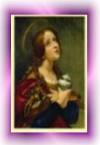Benedict and Scholastica were born around the year 480 AD, just four years after the final sack of Rome in 476 by Odoacer. They were born in Nursia, a town in the beautiful Umbria region of Italy (where Assisi is also located). Scholastica consecrated herself to God as a young girl. When her brother Benedict moved to Monte Cassino to lead the monastery there, Scholastica moved to the same region of Italy and founded a convent for women about five miles away. We know that St. Benedict was head of both monks and nuns, so it seems that Scholastica was abbess of her community, but took spiritual and practical direction from her brother. Their Benedictine orders are still thriving all over the world today.
Once a year, Benedict and Scholastica would visit one another. Since Scholastica was not allowed to enter her brother’s monastery, they would meet at a nearby house. The two siblings spent their time in prayer and conversation.
The years passed, Scholastica and Benedict grew older, and one year (543), it became clear to Scholastica that the next visit would be their last. After passing the whole day together, Benedict and Scholastica sat down to dinner. Scholastica begged her brother to stay with her throughout the evening and until the next day, so they could continue their discussions of God, of love, of heaven.
Benedict was unwilling to break his famous rule, which has gone on to shape the history of monasticism, in order to stay a night away from his monastery. Scholastica saw that she would not be able to convince him to stay. So she placed her head upon his hands, which were folded at the table, and implored God to move his heart that she might spend more time with her beloved brother.
Suddenly, a great storm arose with violent lightning and thunder, and Benedict could not leave. “What have you done, sister?!” he exclaimed.
“I asked you a favor, and you refused it,” she said. “I asked it of God, and God has granted it. Go off, now, leave me and return to your monastery, if you can.”
They spent the night talking, and Benedict returned to his monastery the next morning. Three days later Scholastica died. Scholastica’s biographer, St. Gregory the Great, Benedictine monk and later Pope, recorded this story in his Life of Benedict and noted of Scholastica’s prayer: “she who had the greater love had the greater power.”
Benedict had a vision that Scholastica had died, and he retrieved her body and buried it in a tomb that he prepared himself.

